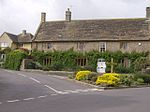Thornford railway station
DfT Category F2 stationsFormer Great Western Railway stationsPages with no open date in Infobox stationRailway request stops in Great BritainRailway stations in Dorset ... and 3 more
Railway stations in Great Britain opened in 1936Railway stations served by Great Western RailwayUse British English from October 2017

Thornford railway station serves the village of Thornford, in Dorset, England. It is approximately 3 miles (4.8 kilometres) to the south of Yeovil, and 144.35 miles (232.31 kilometres) from the zero point at London Paddington (measured via Swindon and Westbury). It is managed by Great Western Railway and is served by trains on the Heart of Wessex Line between Bristol Temple Meads and Weymouth.
Excerpt from the Wikipedia article Thornford railway station (License: CC BY-SA 3.0, Authors, Images).Thornford railway station
Longford Road,
Geographical coordinates (GPS) Address External links Nearby Places Show on map
Geographical coordinates (GPS)
| Latitude | Longitude |
|---|---|
| N 50.9107 ° | E -2.5792 ° |
Address
Thornford
Longford Road
DT9 6QP , Thornford
England, United Kingdom
Open on Google Maps









